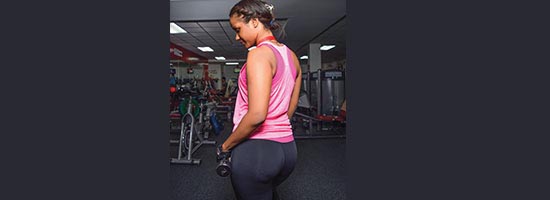The Gluteus muscle, otherwise known as glutes or the buttocks, is one of the strongest muscles in the human body. Functionally, this muscle is responsible in part, for everyday movements like standing from a seated position, walking, running, and of course the most obvious, climbing stairs. A strong Gluteus muscle also carries with it the aesthetic appeal of curvature, enhancing both the male and female form. If however, you are not genetically endowed with this asset, all is not lost. Like any muscle in the human body, your glutes can be trained and shaped to grow into one that rivals any world-class sprinter.
Squats and lunges are the key weapons you should utilise in your arsenal to achieve strong glutes. To perform a standard squat, stand with your feet shoulder width apart and then bend the knees, lowering your glutes to the floor (the movement is similar to sitting in a chair). Return to a standing position, squeezing the glutes at the end of the movement. There are many forms of squats you can engage in, with or without weights, including wide-leg, closed-leg, singleleg, wall, jump or split squat among many others; the placement of the feet being the key differentiator. To perform a lunge, stand with feet together; step forward with one leg, while bending the rear stationary leg, bringing the knee towards the floor. At this point both legs should be bent at the knees at ninety degree angles, one in front the other. Push through the front heel to return to a standing position, feeling the tension in the glute area. There is also a variety of lunges including the forward, reverse, side, jump or switch lunge, again with or without weights.

Now then, lets be clear. No fitness routine aimed at shaping and developing the Gluteus muscle is complete without the inclusion of squats and lunges. However, there are additional exercises that have
also proven to yield desirous effects, such as stair-climbing, step ups (stepping up on a high box or ledge) or standing kickbacks using a cable machine or resistance band. Incorporating these exercises along with squats and lunges as part of your lower body routine (2-3 times per week for maximum results) and progressively increasing the challenge or resistance as you adapt, is vital to your success.
To continue reading , purchase Vol. 8 #1 2015 issue


Share this post:
The Gluteus muscle, otherwise known as glutes or the buttocks, is one of the strongest muscles in the human body. Functionally, this muscle is responsible in part, for everyday movements like standing from a seated position, walking, running, and of course the most obvious, climbing stairs. A strong Gluteus muscle also carries with it the aesthetic appeal of curvature, enhancing both the male and female form. If however, you are not genetically endowed with this asset, all is not lost. Like any muscle in the human body, your glutes can be trained and shaped to grow into one that rivals any world-class sprinter.
Squats and lunges are the key weapons you should utilise in your arsenal to achieve strong glutes. To perform a standard squat, stand with your feet shoulder width apart and then bend the knees, lowering your glutes to the floor (the movement is similar to sitting in a chair). Return to a standing position, squeezing the glutes at the end of the movement. There are many forms of squats you can engage in, with or without weights, including wide-leg, closed-leg, singleleg, wall, jump or split squat among many others; the placement of the feet being the key differentiator. To perform a lunge, stand with feet together; step forward with one leg, while bending the rear stationary leg, bringing the knee towards the floor. At this point both legs should be bent at the knees at ninety degree angles, one in front the other. Push through the front heel to return to a standing position, feeling the tension in the glute area. There is also a variety of lunges including the forward, reverse, side, jump or switch lunge, again with or without weights.
Now then, lets be clear. No fitness routine aimed at shaping and developing the Gluteus muscle is complete without the inclusion of squats and lunges. However, there are additional exercises that have
also proven to yield desirous effects, such as stair-climbing, step ups (stepping up on a high box or ledge) or standing kickbacks using a cable machine or resistance band. Incorporating these exercises along with squats and lunges as part of your lower body routine (2-3 times per week for maximum results) and progressively increasing the challenge or resistance as you adapt, is vital to your success.
To continue reading , purchase Vol. 8 #1 2015 issue
Share this post: